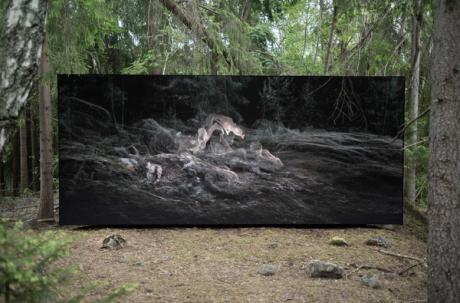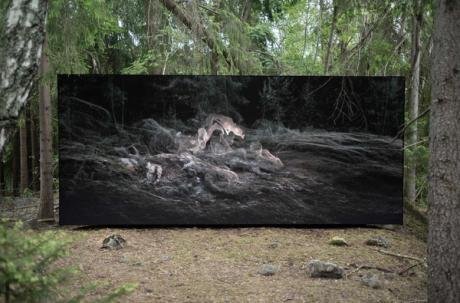
The French artist Pierre Huyghe embraces site-specific work to explore the boundaries between humanity, nature and the synthetic. Over the past decade, Huyghe has created outdoor sculptures that included active bee colonies and “scanned” a Norwegian forest to generate an ongoing, cinematic narrative about a real place. Huyghe planted a garden with hallucinogenic and carnivorous plants and transformed a skating rink into a watery, earthen environment. Now, for his largest exhibition to date, the artist returns to an institutional setting. He honours its constraints as he reconsiders the possibilities and limitations of artificial intelligence (AI)and machine sentience.
Liminal is spread across the massive, 3,500 sq. m space at Punta della Dogana. The presentation is organised by the independent curator Anne Stenne, who has worked with Huyghe since 2014 and views Liminal as the beginning of a new cycle for the artist. “Usually the site triggers the fiction that will unfold and create the condition for the work to exist,” Stenne says. “Here, he brings the fiction to the site.”
Liminal features over a dozen works, including five new pieces. The materials tell a story of evolving technologies: earlier works include aquariums, live marine ecosystems and film, while more recent pieces are made of “robotics driven by machine learning” with voices and edits generated by AI. Sensors abound throughout Liminal, integrating real-time information about visitors and the space into the show’s evolving presentation.
Humans meet non-humans
The exhibition title, Stenne says, suggests “a passage between the sensible reality in which we are living—or Pierre is giving access to—and the inhuman or non-human entities that inhabit the exhibition.” The human and non-human gradually impact on each other as the show unfolds.
Liminal, the eponymous work of the show, is a real-time simulation-on-film that resembles a female body with a void instead of a head. During the exhibition, Liminal’s subjectivity will shift according to inputs from environmental factors—the weather, for example, and the presence of visitors. AI will inform how the simulation develops, as well as data extracted from a synthetic brain organoid developed in a lab at New York’s Rockefeller Center. Liminal will be able to feel pain, Stenne says, not as humans do “when we burn ourselves”, but as “a plant will change orientation because it doesn’t want to burn in the sun”.
Two other new works, provisionally titled Inexistants and Idiom, use AI to different ends. Inexistants is a film without beginning or end, edited in real time by AI. It depicts a mysterious ritual around an unburied skeleton in Chile’s harsh Atacama Desert, with robotic arms performing what might be funeral rites. Idiom is a new language, unintelligible by humans, which AI will produce over the course of the show. Mute human carriers will circulate with golden LED screen masks, which capture information and integrate it into the new “idiom”.
The French philosopher Jean-François Lyotard asked, “can thought go on without a body?” Huyghe explores what it means to exist in a moment before humanisation, before domestication and adult awareness. His works may give us richer understandings of that state.
• Pierre Huyghe: Liminal, Punta della Dogana, Dorsoduro 2, until 24 November









